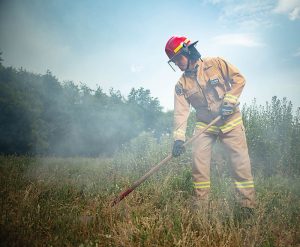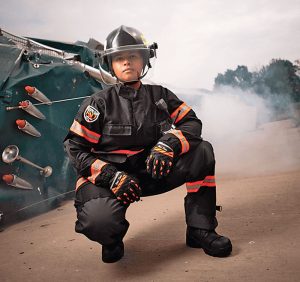
Firefighter apparel is not a one-product-fits-all scenario —different emergencies may require different gear.
By Todd Herring
This summer’s wildland fire forecast — above normal potential from Texas and Oklahoma clear out to the Western slopes — is a reminder to men and women on the line that their personal protective equipment (PPE) gear must have the flexibility to go from manageable to lifesaving, often in minutes.
Modern firefighters are constantly toggling between structure protection, vehicle crashes, medical calls and many other types of emergencies. Yet for decades, gear strategy has typically called for structural turnouts for every call, whether a four-alarm blaze or an overheated transformer.
The problem is that turnouts are designed for high-heat fire suppression, not hours of movement in extreme outdoor heat, and that mismatch can take a special toll on the health and performance of wildland firefighters.
Shifting To Alternative PPE
National Fire Protection Association (NFPA) records leave no doubt that the number of structural fires has taken a steep dive over the last 40 years.1 Meanwhile, EMS responses have dramatically multi-plied — to 421 percent higher than before — and non-fire calls across the board are close to triple the old counts.
Wearing flashover-rated turnouts to handle a roadside crash in triple-digit heat, for instance, probably means hauling weight you don’t need, trapping heat you can’t shed and pushing your body toward the kind of overexertion that too often leads to heat stress.
The good news is that gear is get-ting smarter as materials are getting lighter without losing their protective edge. And maybe most importantly, departments are beginning to talk about “right gear for the right call” as a legitimate operational philosophy rather than a luxury.
Not Just A Nice-To-Have
Alternative PPE, or gear built specifically for nonstructural fire calls, has been around for years, but is still considered “optional” for many departments. The reality, however, is that it’s more like an insurance policy for both the firefighter’s body and the department’s budget.
On the health side, the case is straightforward in terms of lighter, more breathable gear that helps regulate core body temperature and reduce fatigue. When you lower the strain on the body, you preserve cognitive performance, decision-making and physical capacity over long shifts. And if that gear is kept separate from structural turnouts, it also reduces the amount of toxic contamination that firefighters carry back to the truck or station, as shown in studies such as one published in the International Journal of Hygiene and Environmental Health.2
On the financial side, alternative PPE keeps turnouts fresher for when they’re truly needed. It’s not unusual for departments to get years of additional service out of their most expensive gear by rotating in multi-purpose gear for the high-volume, low-heat calls.

Science Under The Seams
The real leap forward has come from materials science. Looking at TECGEN® fiber from Medina, Ohio-based Fire-Dex LLC, for example, it’s easy to assume at first that it’s just another carbon fiber. But it’s not. Rather, the fiber comprises a viscoelastic core that is encased in a high-density carbon shell. This structure provides the thermal protection of carbon fiber without its biggest drawback — brittleness —making it far better suited for fabric blends that need to breathe and move with the body.
TECGEN first entered the fire service in 2008 as part of rescue gear, and by 2015, it became exclusive to the Fire-Dex brand. TECGEN51 — originally introduced in 2011 by the TEC-GEN team as TECGEN XTREME — was purpose-built as a single-layer fabric for nonstructural emergencies. Fire-Dex acquired the technology in 2015, and partnered with Spartanburg, S.C.-based Milliken & Company — a manufacturer recognized for its NFPA-compliant fabrics — who began producing the material under license to ensure a consistent, large-scale supply.
Dual-certified to NFPA 1951 — for technical rescue — and NFPA 1977 — for wildland performance — TECGEN51 delivers the abrasion resistance, thermal protection and breathability needed for everything from motor vehicle accidents to wildland-urban interface (WUI) operation, but without the weight and heat load of multiple heavier layers.
However, if the design doesn’t match the realities of the job, the best fabric in the world still doesn’t help achieve the goal. For alternative PPE, every detail must be scrutinized through the lens of movement, heat dissipation and hazard coverage, including:
- Mobility — Bi-wing backs in jackets let shoulders move freely when climbing, hauling or carrying tools.
- Debris Defense — Mandarin-style collars keep grit and embers out without adding the bulk of a traditional turnout collar.
- Ease of Donning — Oversized pant legs with long zipper openings make it easy to quickly pull gear over boots.
- Targeted Reinforcement —High-wear zones like knees and cuffs get abrasion-resistant overlays without adding weight across the entire garment.
Taken alone, these features don’t create a lot of buzz, but add them up, and they cut fatigue and help firefighters stay sharp when it matters most — and that’s worth getting excited about.
The Wildfire Connection
So, what does all this have to do with the looming wildfire season?Everything. Fighting fire in the WUI is a different game than a traditional structure fire. Firefighters are moving constantly, covering distance and working in full sun. The radiant heat from the fire is only part of the equation as the ambient temperature, gear insulation and exertion can all stack up fast.
Imagine running a marathon in full winter gear: runners will finish slower, heavier and hotter, of course. And that’s what turnouts can feel like in the WUI, and why alternative PPE is finding the firm middle ground with heat and abrasion protection, plus the comfort to last through the shift.
Departments that embrace a “gear match” philosophy by investing in PPE built for the actual risks of wildland firefighting — and a growing litany of non-fire scenarios — are going to have an edge going forward that will show up in firefighter endurance, incident outcomes, gear longevity and long-term health metrics.
Weather patterns, the topography or the fuel load cannot be controlled. But how the people running toward the fire line are equipped can be controlled. And in this new normal, that choice might be the single biggest factor in keeping them safe and ready for whatever comes next.
References:
1 NFPA Research; Fire Department Calls; accessed 8.12.25. https://www.nfpa.org/education-and-research/research/nfpa-research/fire-statistical-reports/fire-department-calls?l=58
2 Air pollution inside fire stations: State-of-the-art and future challenges; January 2024. https://www.science direct.com/science/article/pii/S1438463923001803?via%3Dihub
Editor’s Note: Todd Herring is vice president of Product Innovation and Strategy, Fire-Dex, Medina, Ohio.
2025 Quarterly Issue III




